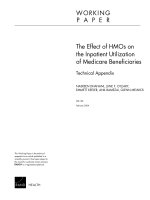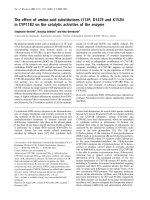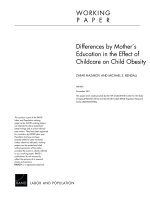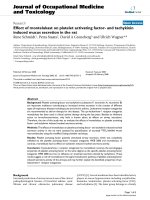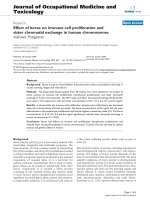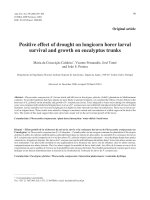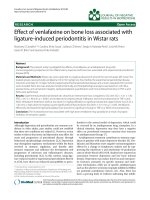- Trang chủ >>
- Văn Mẫu >>
- Văn Nghị Luận
effect of bha on longevity antioxygenic enzymes and peroxides in
Bạn đang xem bản rút gọn của tài liệu. Xem và tải ngay bản đầy đủ của tài liệu tại đây (364.35 KB, 0 trang )
<span class='text_page_counter'>(1)</span><div class='page_container' data-page=1>
<b>Pergamon </b>
Experimental Gerontology, Vol. 29, No. 5, pp. 58~591, 1994
Copyright © 1994 Elsevier Science Ltd
Printed in the USA. All rights reserved
0531-5565/94 $6.00 + .00
0531-5565(94)E0025-W
<b>EFFECT OF BHA ON LONGEVITY, ANTIOXYGENIC ENZYMES </b>
<b>AND PEROXIDES IN </b>
<i><b>CALLOSOBRUCHUS MACULATUS </b></i>
S. MAHAJAN, S. K. GARG and T. S. LOBANA I
Department of Molecular Biology & Biochemistry, 1Department of Chemistry, Guru Nanak Dev
University, Amritsar 143 005, India
<b>A b s t r a c t - - L i f e </b>span and antioxygenic enzyme activities of insects reared on optimal
BHA concentration (1 mM) soaked seeds were higher than their respective controls.
However, the reproductive potential, peroxides and the level of free radicals de-
clined. The increased longevity with BHA could be attributed to its free radical
quenching effect, thereby leading to the decreased peroxide levels and the increased
antioxygenic enzyme activities of the insects.
<b>Key Words: </b><i><b>C. maculatus, </b></i><b>longevity, antioxygenic enzymes, peroxides, BHA </b>
I N T R O D U C T I O N
ANTIOXYGENIC ENZYMES and antioxidants are the natural defences against the delete-
rious effects of oxygen and oxidative products. However, despite the existence of such
a system, free radicals accumulate as inorganic and lipid peroxides and their effect is
accentuated in the presence of iron (Halliwell, 1981). Dietary antioxidants supplement
the function of antioxygenic enzymes (Munkres and Rana, 1984) and are most effective
during development (Neigdauz and Ravin, 1984). Further, the antioxidants inhibit lipid
peroxidation by way of keeping the metal ions and other catalysts in the unreactive
form, thereby increasing the life span (Gutteridge, 1982). Butylated hydroxyanisole
(BHA) has been widely used as an antioxidant (Sims and Fioritti, 1980). Its use as food
additive has been suggested as generally recognized as safe by Wattenberg (1985).
However, the information regarding the effect of antioxidants on nonfeeding insects is
completely obscure. <i>C. maculatus, </i>a southern cow-pea weevil, starts its life cycle with
Correspondence to: S. Mahajan, Department of Molecular Biology & Biochemistry, Amritsar 143 005,
India.
</div>
<span class='text_page_counter'>(2)</span><div class='page_container' data-page=2>
<b>the laying of eggs immediately after emergence on the seeds of legumes. Larvae after </b>
<b>hatching from the eggs develop into an adult after settling and feeding inside the en- </b>
<b>dosperm. Feeding in the adult is nonexistent, thereby making its life span and repro- </b>
<b>ductive potential dependent upon the nutrition derived during the developmental </b>
<b>phases. The present investigation was designed to study the hypothesis that free rad- </b>
<b>icals generated during the larval phase transfer their impact to the adult organism and </b>
<b>further that the effect of antioxidants given during the larval phase is passed on to the </b>
<b>adult, thereby increasing the longevity of the organism by altering the physiological and </b>
<b>biochemical parameters. In view of this, the present report deals with the effect of BHA </b>
<b>on longevity, fecundity, antioxygenic enzymes, peroxides, iron content, and free rad- </b>
<b>icals in </b><i><b>C. maculatus. </b></i>
T A B L E 1. E F F E C T OF BHA ON MEDIAN (LT5o) AND MAXIMUM (LTIoo) L I F E SPANS, A G E - I N D E P E N D E N T
SUSCEPTIBILITY TO DEATH (ao) , L I F E EXPECTANCY (ex), MEAN NUMBER OF EGGS L A I D / F E M A L E AND
REPRODUCTIVE AND POSTREPRODUCTIVE PERIODS <i>IN C. m a c u l a l u s </i>
<i>BHA (raM)soaked </i>
<i>Water </i> <i><b>Ethanol </b>(10%) </i>
<i>Treatment </i> <i>Unsoaked </i> <i>soaked </i> <i>soaked </i> <i>O. 1 </i> <i>0.25 </i>
<b>Male </b>
LTso (days) 6.1 ± 0.2 9.2 +- 0.6 8.3 -+ 0.03 8.6 ± 0 . 0 6 t 9.9 ± 0.055
L T ] ~ (days) 10.0 -+ 0.0 t7.3 -+ 1.2 15.0 -+ 0.0 15.0 ± 1.0 16.7 -+ 0 . 3 t
<b>a o </b> 1.07 -+ 0.03 - 1 . 6 4 -+ 0.11 1.55 + 0.03 - 2 . 0 3 -+ 0.06t - 1 . 6 9 ± 0.12
e~ (days) 5.9 8,97 8.32 9.33 9.54
<b>Female </b>
LTso (days) 4.5 ± 0.2 8.1 +- 0.3 6.8 ± 0.2 7.9 -+ 0.2* 8.6 + 0.2+
L T i o o (days) 8.1) ± 0.0 18.7 ± 1.2 17.0 ± 0.9 20.0 -+ I.I 21.3 -+ 1.0"
<b>a o </b> 0.58 ± 0.05 0.98 -+ 0.30 - 1 . 2 8 ± 0.06 - 1 . 2 9 ± 0.21 1.08 -+ 0.20
e~ (days) 4.3 8.85 7.35 8.54 9,27
<b>N u m b e r o f </b>
<b>eggs/female </b> 47.0 ± 1.4 88.8 ± 1.6 74.4 + 1.3 49.8 -+ 1.3+ 45.1 -+ 1.9 +
<b>Reproductive </b>
<b>period (days) </b> 5.3 ± 0.3 8.3 + 0.3 8.3 ± 0.5 8.0 -+ 0.0 8.3 -+ 0.5
<b>Post- </b>
<b>reproductive </b>
<b>period (days) </b> 2.7 ± 0.3 t0.4 + 0.3 8.7 -+ 0.5 12.0 ± 0.0+ 13.0 -+ 0.5+
<i>BHA (raM) soaked </i>
<i>0.5 </i> <i>0.75 </i> <i>I </i> <i>2.5 </i> <i>5 </i> <i>10 </i>
12.3 + 0.55 12.9 + 0.15 13.7 + 0.15 12.3 -+ 0.35 10.7 -+ 0.25 8.3 ± 0.2
17.3 + 0.7* 19.7 ± 1.2" 20.7 -+ 0.55 20.0 +- 0.7+ 16.3 -+ 0.9 15.0 ± 0.6
<b>- </b>1.95 -+ 0,09* - 2 . 0 9 ± 0.19" 1.93 -+ 0.04+ 1.72 -+ 0.06* - 1.69 + 0.07 1.79 ± O.03t
12.08 12.52 13.53 11.99 10.00 8.46
10.7 -+ 0,1+ 11.1 -+ 0.1+ 12.8 + 0.05+ 10.0 -+ 0.2~ + 8.6 ± 0 . 3 t 7.5 -+ 0.1"
22.0 ± 0,6* 22.3 +- 0 . 7 t 22.0 -+ 0.5+ 22.0 -+ 1.0" 18.6 ± 0.5 17.0 -+ 1.0
- 1 . 3 1 ± 0.20 1.46 -+ 0.13 1.78 -+ 0.01" 1.53 -+ 0.18 - 1 . 1 7 +- 0.11 1.23 -+ 0.07
11.05 I 1.41 12.69 9.73 9.11 8.14
51.i ± 4,0+ 43.3 -+ 0.08~: 33.5 -+ 5.4+ 49.8 + 6.9+ 45.9 -+ 3.45 65,3 + 2.4+[:
7.0 ± 0.8* 7.0 ± 0.0+ 7.0 ~ 0.05 7.3 ± 0.5* 7.0 -+ 0.8* 7.3 ± 0.5*
15.0 + 0.55 15.3 ± 0.0+ 16.7 -+ 0.05 14.7 ± 0.55 11.6 +- 0.8+ 9.6 -+ 0.5*
<b>Values are Mean </b>+ S E <b>of three experiments. </b>
</div>
<span class='text_page_counter'>(3)</span><div class='page_container' data-page=3>
EFFECT OF BHA IN <i>CALLOSOBRUCHUS MACULATUS </i>
MATERIALS AND METHODS
587
Fresh <i>Vigna radiata </i>(vern. mung) seeds were soaked in different concentrations (0,
0.25, 0.5, 0.75, 1, 2.5, 5, and 10 mM) of BHA dissolved in ethanol (10%), dried in shade
and were infested with pure cultures of <i>C. maculatus </i> maintained at 28 +- I°C and
60--70% humidity. Longevity and fecundity studies were carried out on insects emerg-
ing from unsoaked, water, 10% ethanol (control) and BHA soaked seeds (Mahajan and
Garg, 1992). Optimal concentration increasing median (LT50) and maximum (LTlo0) life
spans was selected to observe its effect on catalase (Kar and Mishra, 1976), peroxidase
(Kumar and Khan, 1983), glutathione reductase (Tyson <i>et al., </i>1982) inorganic peroxides
(HzO 2) (Bernt and Bergmeyer, 1976), lipid peroxides (MDA) (Hasan and Ali, 1981), iron
content (Vogel, 1982) and free radicals (Buchvarov and Gantcheff, 1984) in whole-body
homogenates of the two sexes at different intervals starting from emergence to beyond
the median life span. The enzymes and peroxides were determined in supernatants
obtained after centrifugation. The protein content was measured by Lowry <i>et al. </i>(1951)
for calculating the specific activity of the enzymes.
For iron, bruchids were digested in HCI and perchloric acid for 4 h at 420°C using
Tecator 1016 digestion system. The residue left after acid evaporation was dissolved in
distilled water and analyzed subsequently. The powdered insect samples after filling in
glass capillaries (2 mm diameter) were analyzed semiquantitatively for free radicals
using X-band (9.44 GHz) JES-FE3XG ESR spectrometer at a field range of 3,000 -
2,500 gauss. The g value was calculated following Drago (1977). Experiments were
repeated four times to confirm the reproducibility and the data were analyzed employ-
ing Student's t test.
T A B L E 2. E F F E C T OF BHA (1 mM) ON SPECIFIC A C T I V I T Y OF C A T A L A S E , P E R O X I D A S E , A N D G L U T A T H I O N E
R E D U C T A S E IN W H O L E BODY H O M O G E N A T E S OF A G E I N G <i>C. MACULATUS </i>
<i>Male </i> <i>Female </i>
<i>Age </i> <i>Ethanol (10%) </i> <i>Ethanol (10%) </i>
<i>Enzyme </i> <i>(days) </i> <i>soaked </i> <i>BHA soaked </i> <i>soaked </i> <i>BHA soaked </i>
Catalase 1 64.5 ± 1.1 91.1 -+ 3.6t 67.7 ± 1.3 118.6 +- 1.7t
(ixM H202 decomposed/100 rag/ 3 93.3 ± 1.7" 214.8 ± 4.8"+ 75.5 -+ 7.1 131.5 -+ 4 . 2 " t
min at 25°C/mg protein) 5 80.4 +- 4.5* 207.1 ± 5.2** 83.2 ± 3.1" 154.1 ± 3.8**
7 84.8 ± 1.8" 165.3 -+ 2.9"t 76.1 -+ 0.7* 141.3 ± 1.8"+
9 86.5 ± 0.9* 191.9 +- 5.1"+ 78.4 ± 3.3* 146.4 +- 2.0*+
Peroxidase 1 3.9 ± 0.05 6.0 ± 0 . I t 5.9 ± 0.2 7.6 -+ 0.3t
(~M purpurogallin formed/ 3 6.5 ± 0.1" 7.0 -+ 0.2* 5.4 ± 0.1 8.0 +- 0.5*
100 mg/min at 25°C/mg protein) 5 7.2 +- 0.2* 6.6 -+ 0.2* 6.6 ± 0.3 7.6 ± 0.2t
7 7.6 +- 0.5* 6.6 ± 0.2* 5.7 ± 0.1 5.7 -+ 0.3*
9 6.4 ± 0.1" 6.1 ± 0.1 5.2 ± 0.06* 5.5 ± 0.09"*
Glutathione reductase 1 6.1 ± 0.3 10.3 ± 0.5+ 5.4 ± 0.1 9.1 ± 0.2+
(~tg G S H produced/100 mg/min 3 7.8 ± 0.1" 10.4 -+ 0.3t 6.5 ± 0.2* 9.6 +- 0.2+
at 30°C/rag protein) 5 7.5 ± 0.1" 9.6 ± 0.2t 5.9 ± 0.4 8.5 ± 0.2t
7 8.5 ± 0.3* 8.9 -+ 0.2* 5.4 ± 0.2 8.3 -+ 0.3t
9 7.5 ± 0.6 7.4 ± 0.2* 5.0 ± 0.2 7.9 ± 0.7t
V a l u e s a r e M e a n + S E o f f o u r e x p e r i m e n t s .
</div>
<span class='text_page_counter'>(4)</span><div class='page_container' data-page=4>
<b>70 </b>
<b>60 </b>
<b>50 </b>
<b>n~ </b> <b>4 0 </b>
2O
<b>g </b>
o 0
M a l e Femole M a l e
-]1
]]]7~]9
Age (days)
Female Male Female
Lipid peroxides
Inorgonic peroxides
Iron
FIG. 1. Percent decrease with respect to control in lipid peroxides, inorganic peroxides and
iron content in B H A (1 mM)-treated <i>C. maculatus. </i>
R E S U L T S
Female insects emerging from unsoaked seeds were short lived than males and this
decreased life span was accompanied by higher age-independent susceptibility to death
<i>(ao) </i>and low life expectancy <i>(ex). </i>Presoaking of seeds in water increased the life span
of insects and a similar observation was made with 10% ethanol soaking. B H A treat-
ment increased the LTso and LTl0o values and <i>e~; </i>decreased <i>a o, </i>mean number of eggs
laid/female as well as reproductive phase and prolonged the postreproductive period
with a maximum change at 1 mM concentration in comparison to the control cohorts
(Table 1).
Age-related change in the activities of catalase, peroxidase, and glutathione reduc-
tase in insects emerging from ethanol and BHA soaked seeds was observed except for
glutathione reductase in females. On BHA treatment, the activity of antioxygenic en-
zymes generally elevated and the peroxides and iron content declined as compared to
the control cohorts. The percent rise was, however, more for catalase (Table 2, Fig. 1).
ESR spectra of 1 and 5 day old bruchids infesting unsoaked, ethanol and B H A (1
raM) soaked seeds revealed a single sharp peak of free radicals with a spectroscopic
splitting factor (g) in the range of 2.00-2.08 and line width between 0-13 gauss. The
peak heights were lower in BHA-treated insects (Table 3). Some of the spectra showed
<b>T A B L E 3. E F F E C T OF BHA (1 raM) ON ESR PEAK H E I G H T S (cm) IN </b>
<i>C . MACULATUS </i>
<i>Ethanol (10%) </i> <i>BHA </i>
<i>Age </i> <i>Unsoaked </i> <i>soaked </i> <i>soaked </i>
Male 1 5.7 5.0 2.1
5 8.5 8.5 5.4
Female 1 8.5 6.0 1.5
</div>
<span class='text_page_counter'>(5)</span><div class='page_container' data-page=5>
EFFECT OF BHA IN <i>CALLOSOBRUCHUS MACULATUS </i> 589
<b>an additional broad peak indicative of the presence of ferric ions (Fe + 3). It was further </b>
<b>evidenced by heating samples of one day old males infesting unsoaked seeds at 50, 100, </b>
<b>150, 200, and 250°C. The ESR peaks clearly showed the presence of Fe + 3 above 100°C </b>
<b>with a g value ranging between 2.03-2.09 (Fig. 2). </b>
0.,
\ .
f<b>1 0 0 ° </b>
\ ~ _ ~ - - - - ~ c ° .
b
^,
/
s'
i'
<b>t </b>
<b>q </b>
<b>I , </b>
u
/
f ~ 200 ~
2500 <b>3000 </b> ]500 O0 )000 ]500 ~)00
<b>M a g n e t i c </b> <b>f i e l d </b> <b>( g a u s s ) </b>
</div>
<span class='text_page_counter'>(6)</span><div class='page_container' data-page=6>
DISCUSSION
Low life expectancy of female <i>C. m a c u l a t u s </i>may be attributed to its higher metabolic
rate during reproductive period to meet increased energy demands as compared to the
males. The longevity in <i>C. m a c u l a t u s </i> increased with the concentrations of BHA up to
I mM followed by a decline at higher doses. This may be explained in terms of antiox-
idative properties of B H A at lower concentrations and prooxidant effect of this antiox-
idant at higher doses (Kahl <i>et al., </i> 1989). Further, life prolonging effect of BHA was
correlated to its free-radical quenching nature and conservation of energy by way of
significant reduction in the length of reproductive period and number of eggs laid/
female as reported earlier (Mahajan and Garg, 1992). The increased longevity of BHA-
treated insects may also be explained in terms of decline in peroxides, iron content and
free radicals (Table 3, Fig. 1). However, the impact of the antioxidant by way of
decreased metabolism (Emanuel and Obukhova, 1978) cannot be discounted. Dubick <i>et </i>
<i>al. </i>(1982) reported the elimination of destructive oxidative effects of oxygen on removal
of metals from the culture medium. A comparison between insects emerging from
water-soaked and 10% ethanol-soaked seeds reveals that alcohol as a solvent does not
influence the longevity and reproductive characteristics of insects.The increase in the
levels of antioxygenic enzymes with B H A could be extrapolated from the increased
mRNA biosynthesis as observed by Semsei <i>et al. </i>(1989) in diet restricted male rats. The
increased activity of antioxygenic enzymes and decreased iron content on BHA treat-
ment support the fact that antioxidants decrease lipid peroxidation. Sohal <i>et al. </i>(1990)
suggested that the maximum life of an organism is related inversely to H202 production
and directly to antioxygenic defenses. Further, Zs.-Nagy (1987) suggested that the
decreased free radical production consequent to efficient antioxygenic enzyme system
may result in less accumulation of lipid peroxides as observed in the present case. In
addition, the pronounced increase in catalase level is suggestive of its important role in
the survival of <i>C. m a c u l a t u s . </i> Moreover, the present findings are indicative of the
maintenance of strong reducing environment by declined inorganic and organic perox-
ide levels (Bains <i>et al., </i> 1992; Sharma <i>et al., </i> 1992). Therefore, the increased longevity
of <i>C. m a c u l a t u s </i>emerging from BHA soaked seeds could be attributed to decreased free
radicals which inflict damage to the DNA, thereby stimulating the generation of an-
tioxygenic enzymes.
<i>Acknowledgments--The </i>senior author is thankful to UGC, New Delhi for SRF.
R E F E R E N C E S
BAINS, J.S., SHARMA, S.P., and GARG, S.K. Effect of propyl gallate feeding on glutathione content in
ageing <i>Zaprionus paravittiger </i>(Diptera). <i>Gerontology </i>38, 192-195, 1992.
BERNT, E. and BERGMEYER, H.U. Inorganic peroxides. In: <i>Methods in Enzymatic Analysis, </i>Bergmeyer
(Editor), vol. 4, pp. 2246-2248, Academic Press, New York, 1976.
B UCHVAROV, P. and G A N T C H E F F , T.S. Influence of accelerated and natural ageing on free radical levels
in soybean seeds. Physiol. <i>Plant. </i>60, 53-56, 1984.
DRAGO, R.S. (Editor) Electron paramagnetic resonance spectroscopy. In: <i>Physical Methods in Chemistry, </i>
pp. 316-353, W.B. Saunders and Co., Philadelphia, PA, 1977.
</div>
<span class='text_page_counter'>(7)</span><div class='page_container' data-page=7>
EFFECT OF BHA IN <i>CALLOSOBRUCHUS MACULATUS </i> 591
E M A N U E L , N.M. and O B U K H O V A , L.K. Types of experimental delay in ageing patterns. <i>Exp. Gerontol. </i>
13, 25-29, 1978.
GUTTER1DGE, J.M.C. Free radical damage to lipids, amino acids, carbohydrates and nucleic acids deter-
mined by thiobarbituric acid reactivity. Int. J. <i>Biochem. </i>14, 649-654, 1982.
H A L L I W E L L , B. Free radicals, oxygen toxicity and ageing. In: <i>Age Pigments, </i> Sohal (Editor), pp. 1-62,
Elsevier/North-Holland Biomedical Press, Amsterdam, 1981.
HASAN, M. and ALl, S.F. Effects of thalium, nickel and cobalt administration on lipid peroxidation in
different regions of the rat brain. <i>Toxicol. Appl. Pharrnacol. </i>57, 8--13, 1981.
KAHL, R., W E I N K E , S., and KAPPUS, H. Production of reactive oxygen species due to metabolic acti-
vation of BHA. <i>Toxicology </i>59, 179-194, 1989.
KAR, M. and MISHRA, D.B. Catalase, peroxidase and polyphenol oxidase activities during rice leaf se-
nescence. <i>Plant Physiol. </i>57, 315-319, 1976.
KUMAR, K.B. and KHAN, P.A. Age-related changes in catalase and peroxidase activities in the excised
leaves of <i>Eleusine coracana </i>Gaetrn. CV PR 202 during Senescence. <i>Exp. Gerontol. </i>18, 409-417, 1983.
LOWRY, O.H., ROSEBROUGH, N.J., FARR, A.L., and RANDALL, R.J. Protein measurement with
Folin-phenol reagent. <i>J. Biol. Chem. </i>193, 265-275, 1951.
MAHAJAN, S. and GARG, S.K. Life prolonging effect of butylated hydroxy anisole in <i>Callosobruchus </i>
<i>rnaculatus </i>F. (Coleoptera: Bruchidae). <i>Arch. Gerontol. Geriatr. </i>15, 71-78, 1992.
M U N K R E S , K.D. and RANA, R.S. Genetic control of cellular longevity in Neurospora crassa: A relation-
ship between cyclic nucleotides, antioxidants and antioxygenic enzymes. <i>Age </i>7, 30-35, 1984.
NEIGDAUZ, B.M. and RAVIN, V.K. The effect of physiologically active compounds on the life span of
nematode, <i>Caenorhabditis elegans. Zh. Biol. 44, </i>835-841, 1984.
SEMSE1, I., RAO, G., and RICHARDSON, A. Changes in the expression of superoxide dismutase and
catalase as a function of age and dietary restriction. <i>Biochem. Biophys. Res. Cornrnun. </i>164, 620-625, 1989.
SHARMA, S.P., BAINS, J.S., and GARG, S.K. Peroxide levels in ageing <i>Zaprionus paravittiger </i>on propyl
gallate feeding. <i>Age </i>15, 45-46, 1992.
SIMS, R.J. and FIORITTI, J.A. Antioxidants as stabilizers for fats, oils and lipid containing foods. In: <i>CRC </i>
<i>Handbook of Food Additives, </i> Furia (Editor), vol. 2, pp. 13-56, CRC Press, Boca Raton, 1980.
SOHAL, R.S., SVENSSON, I., and BRUNK, U.T. Hydrogen peroxide production by liver mitochondria in
different species. <i>Mech. Age. Develop. </i>53, 209-215, 1990.
TYSON, C.A., L U N A N , K.D., and STEPHENS, R.J. Age-related differences in GSH-shuttle enzymes in
NO 2 or 02 exposed rat lungs. <i>Arch. Environ. Health </i>37, 167-176, 1982.
VOGEL, I. Spectroanalytical methods. In: <i>Textbook of Quantitative Inorganic Analysis, </i>Vogel (Editor), pp.
741-742, Longman Group Ltd., England, 1982.
W A T T E N B E R G , L.W. Chemoprevention of cancer. <i>Cancer Res. </i>45, 1-8, 1985.
</div>
<!--links-->

